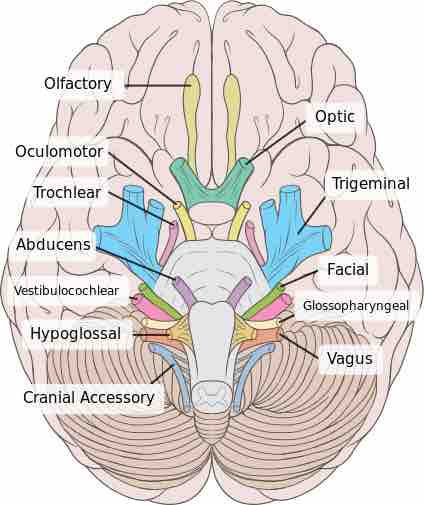The oculomotor nerve is the third paired cranial nerve. It enters the orbit via the superior orbital fissure and controls most of the eye's movements, including constriction of the pupil and maintaining an open eyelid by innervating the levator palpebrae superiors muscle.
The occulomotor nerve is derived from the basal plate of the embryonic midbrain. Cranial nerves IV and VI also participate in control of eye movement.
There are two nuclei for the oculomotor nerve:
- The oculomotor nucleus originates at the level of the superior colliculus. The muscles it controls are the striated muscle in the levator palpebrae superioris and all extraocular muscles, except for the superior oblique muscle and the lateral rectus muscle.
- The Edinger-Westphal nucleus supplies parasympathetic fibers to the eye via the ciliary ganglion, and controls the pupillae muscle (affecting pupil constriction) and the ciliary muscle (affecting accommodation).
Sympathetic postganglionic fibers also join the nerve from the plexus on the internal carotid artery in the wall of the cavernous sinus and are distributed through the nerve, for example, to the smooth muscle of levator palpebrae superioris.
Emergence from Brain
On emerging from the brain, the oculomotor nerve is invested with a sheath of pia mater and enclosed in a prolongation from the arachnoid mater. It passes between the superior cerebellar and posterior cerebral arteries, and then pierces the dura mater anterior and lateral to the posterior clinoid process (to give attachment to the tectorium cerebella), passing between the free and attached borders of the tentorium cerebelli.
It then runs along the lateral wall of the cavernous sinus, above the other orbital nerves, receiving in its course one or two filaments from the cavernous plexus of the sympathetic nervous system, and a communicating branch from the ophthalmic division of the trigeminal nerve.
It then divides into two branches that enter the orbit through the superior orbital fissure, between the two heads of the lateral rectus (a muscle on the lateral side of the eyeball in the orbit). Here the nerve is placed below the trochlear nerve and the frontal and lacrimal branches of the ophthalmic nerve, while the nasociliary nerve is placed between its two rami (the superior and inferior branch of oculomotor nerve).

Cranial nerves
Image of cranial nerves showing the position of the oculomotor nerve.